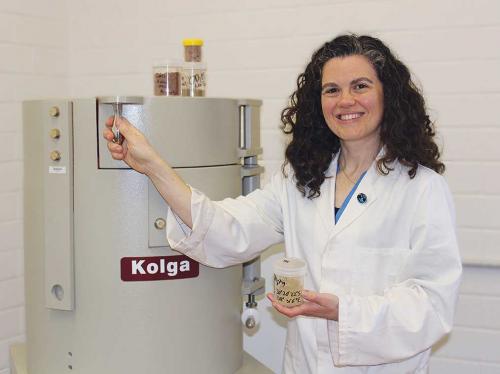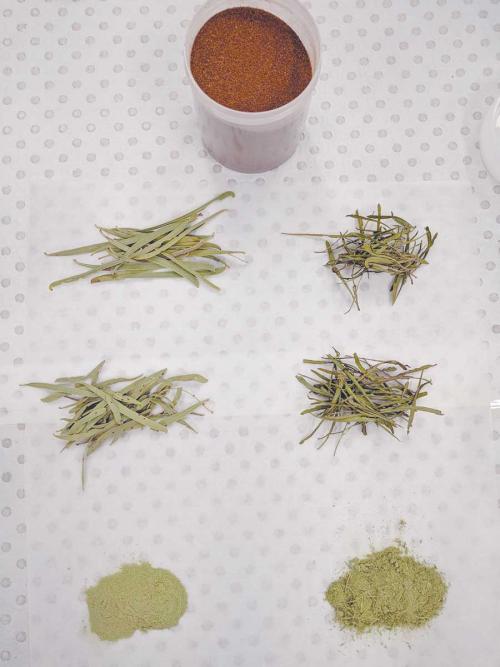With an undergraduate degree in archaeology and a PhD in radioanalytical chemistry, Associate Professor Rachel Popelka-Filcoff from Flinders University is interested in how humans influence the landscape, and how we in turn are influenced by our environment.
Megan Andrews sits down with Rachel to discuss one of her exciting projects – investigating the radioecology of uranium in arid Australian environments surrounding mining sites and shedding new light on the pathways of uranium and its daughter isotopes through local soil, flora and fauna.
So Rachel, what location is your research looking at?
We’re examining the environment surrounding BHP’s Olympic Dam mine in northern South Australia and Beverley uranium mine, operated by Heathgate Resources.
And are the uranium isotopes there a result of the mining activities, or naturally present in the environment?
In the case of Olympic Dam, the background radiation in some areas is lower than it is in Adelaide. Beverley is a little bit different because there’s some naturally occurring radioactivity on the surface.
In particular for Olympic Dam, the mine is hundreds of metres below ground; therefore, there was no indication of the ore on the surface when the mines were discovered and this remains the case today. This is excellent from an environmental perspective but does make our role quite challenging! However, we do need analytical data to understand the impacts, if any, of the mining process on the surrounding environment.
But I gather you are managing to find some?
Although we have not found the levels of isotopes to be elevated, we are able to detect them and reconstruct their pathways in the environment and understand the processes involved. In this environment, we are concerned about the detection of very small amounts of radioactivity and this means that radioanalytical chemistry can be used in a way that’s quite different from other branches of chemistry. We have a high-resolution gamma spectrometer in our laboratory and access to other high-end equipment at Flinders University, and other excellent facilities through our partners.
We are combining it with traditional analytical methods to come up with a powerful way to understand these complex systems.
Who are your partners?
The project is funded by National Energy Resources Australia (NERA) and industry partners BHP and Heathgate Resources. A true testament to the value of the project is that we also have JRHC Consulting, ANSTO (the Australian Nuclear Science and Technology Organisation) and ARPANSA (Australian Radiation Protection and Nuclear Safety Agency) providing significant
in-kind support to make the project a success. ANSTO has an excellent radio-ecology group that we’re collaborating with at the Lucas Heights facility. ARPANSA is the federal regulatory body for radiation, and we are collaborating with them in the use of alpha spectroscopy as well as understanding the regulatory framework.
It’s a really exciting university-, industry- and government-based initiative, which is great because we’re bringing all three sectors together. This collaboration is also valuable for students as it helps to provide skills to the future workforce by giving them exposure to working with industry and government.
Do you get out in the field yourself to obtain samples?
Our team does, yes. We have a few students and a postdoctoral researcher working on the project and they do much of the groundwork in terms of soil and plant samples. And we are working with Arid Recovery, a wildlife sanctuary near Olympic Dam that is reinstating native species in that area. We have been able to acquire some native species like bettongs, and non-natives like feral cats, both of which have been trapped as part of monitoring operations.
And then you analyse these back in the labs.
Yes, but we need to look at it holistically. For example, we need to understand the animals’ roaming ranges, which differ for each species, and try to match their location. And we need to look at the concentration of what we find in the plant or animal relative to the soil, which helps us understand how the plants take up nutrients and materials from the soil.
There is modelling involved and it gets quite complex as we are not just looking at one set of samples and one analytical technique; we’re investigating in terms of both radiation science and chemistry. We are doing some analysis that involves advanced methods that haven’t been used in this area before.
Are there benchmarks you can compare your results to?
There are a couple of recent manuscripts on Australian environments; however, there needs to be a more comprehensive study, which is what we are doing. There are international frameworks for modelling impacts of radiation on the environment, but these are based on organisms that do not live in arid Australia. Therefore, we are establishing baseline data for arid Australian regions, and also figuring out if these international models work in arid Australian environments.
This must be relevant then to other mines then.
Absolutely. The results will be relevant to anyone who needs to undertake radiological risk assessments as part of larger environmental impact assessments. These assessments are often required for mineral sands, rare earths, copper and oil and gas projects. Our results will be available to mining companies and other entities; that’s an important part of the project. The data will be published in journals but will also be freely available in a database for others working in arid Australia – which is most of the country.
When will it be available?
The current project will run until the end of March 2020; however, we have been working in this area since 2016. We are already starting to publish some results as well as presenting them at national and international conferences.




